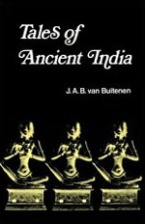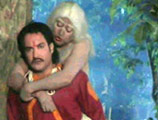
I saw “Tales of Ancient India” while browsing in a second-hand book shop recently. It intrigued me for a number of reasons. First, the printed price was $1.95; it’s been a decade since I came across a book priced under $4.99. Second, the author was named J.A.B. van Buitenen– enough of an inducement in itself. Third, the book was published in 1959 (by the University of Chicago Press), and I’m always curious about North American views of India back in the fifties and sixties, when the country wasn’t the subject of much economic or geo-political interest but viewed (if at all) as a riddle wrapped in a sari inside an enigma…
So I paid my loonie and bought the book–and forgot all about political interpretations and orientalism when I opened it. The first set of tales were the adventures of King Vikram and the Vetaal (vampire). The stories are beloved to me not just from Amar Chitra Kathas of my childhood, but from the old television series back in the days when cable was just another word for telegram. The theme song was devastatingly simple: “Vikram, Vikram, Vikram… Vetaal, Vetaal, Vetaal….” (rinse and repeat till nausea). Here’s a picture from the television series of the Vetaal (who looks, in hindsight, like the putative offspring of Marilyn Manson and M.F.Hussein) perched jauntily on Vikram’s back, telling the king his fabulous stories.
Reading van Buitenen’s translation from the original Sanskrit, I’ve come to realize how sanitized the stories were for our middle-class consumption. It’s not the openness about sex (princes and maidens frolic happily without so much as a mention of marriage) but about death, which is really surprising. People jump into wells and hack off their limbs every few pages, and when they’re shamed, can “barely be prevented by their relatives from killing themselves.” Poisonous snakes lurk under every leaf for the sole purpose of biting comely youths. An angry mother punishes her child’s misbehavior by throwing him “in the blazing fire; and no sooner did the infant fall into the fire than its tender body was burned to ashes.” Whew! But what’s perhaps most interesting is that these stories have no moral. The wicked often prosper; Bad Things happen to Good People; presence of mind often saves the day when virtue fails the task. Very refreshing for someone who grew up reading Enid Blytons…
Besides the Vikram/Vetaal series, the book also features an assortment of other folk and fairy tales with enticing titles such as “The Prince and the Painted Fairy” and “The Red Lotus of Chastity.” As a bonus, all the protagonists have six syllable names with generously sprinkled accents…
I googled J.A.B van Buitenen, and learnt he was one of the foremost experts on Indian history and civilization in his time (he died in 1979)–he was Distinguished Service Professor of Sanskrit and Indic Studies, University of Chicago, from 1974–79. Besides Tales of Ancient India, he’s also published translations of the Mahabharata, and written a series of articles on topics such as Hinduism and Pali Literature for The Encyclopedia Britannica. And Library Thing has graciously let me know that J.A.B stands for Johannes Adrianus Buitenen. I plan to search out all of his work now…


Pingback: DesiPundit » Archives » Vikram, Vetaal and other stories
When we were kids and the Vikram aur Vetaal music came on, my sister would run out of the room. At 3 years old, she was terrified of how the vetaal looked. And looking at this image, who can blame her?? 🙂
Great!
I have heard that there are two main lines of literature from ancient India: (1) mythological, e.g., Upanishads (2)pragmatic, e.g., Panchatantra. There is a middle stream of stories told by mendicants (On the web page http://nextfuture.sriaurobindosociety.org.in/may07/nf_home.htm look for Tales told by mystics).
I think Vetal falls under pragmatic category.
An amusing yet very appropriate comparison between VikramAditya’s stories and the children’s stories thrust down our throats now . . . great post!
It sounds as if you have uncovered a gem! I’ve had little exposure to Indian stories, but a few have popped up in an ebook I’m reading now, “Flowers from a Persian Garden and Other Papers.” It’s a late 19th-century collection of various stories, many from Persia (with origins father east). The are also some rabbinical tales, too. It’s not always the most riveting and some might find the dated writing style soporific, but it’s free, if nothing else:
http://www.gutenberg.org/etext/16949
Shripriya: And who can blame your sister? MFH is real scary 🙂
Mutant: That’s a very interesting classification of Indian lit, thanks for letting me know. I think I prefer the ‘pragmatic’ stories myself…
Arachnid: Thanks, and glad you stopped by!
Mowog: Thanks for the link! I really like the incidental detail in the old stories– where a golden ewer studded with emeralds pours out fragrant water into a silver cup encrusted with rubies… that sort of thing 🙂
Wow, Niranjana, what a find!!! I am going to have to google J.A.B van Buitenen as well…who knows what other treasures from him lie waiting to be discovered?
I am interested in purchasing a good translation of the Mahabharatha (just got one of the Ramayana). Preferrably something that is not too hard to read because, at some point I would like my children (both teenagers) to read it, too. Would you be able to point me to any? Thanks in advance.
Hi Lotus: Sorry about the late reply–been a bit busy…
Have you tried R.K. Narayan’s translation of the Mahabharata? He has a nice accessible style–just the thing to make sense of all the complications and convolutions of the original.